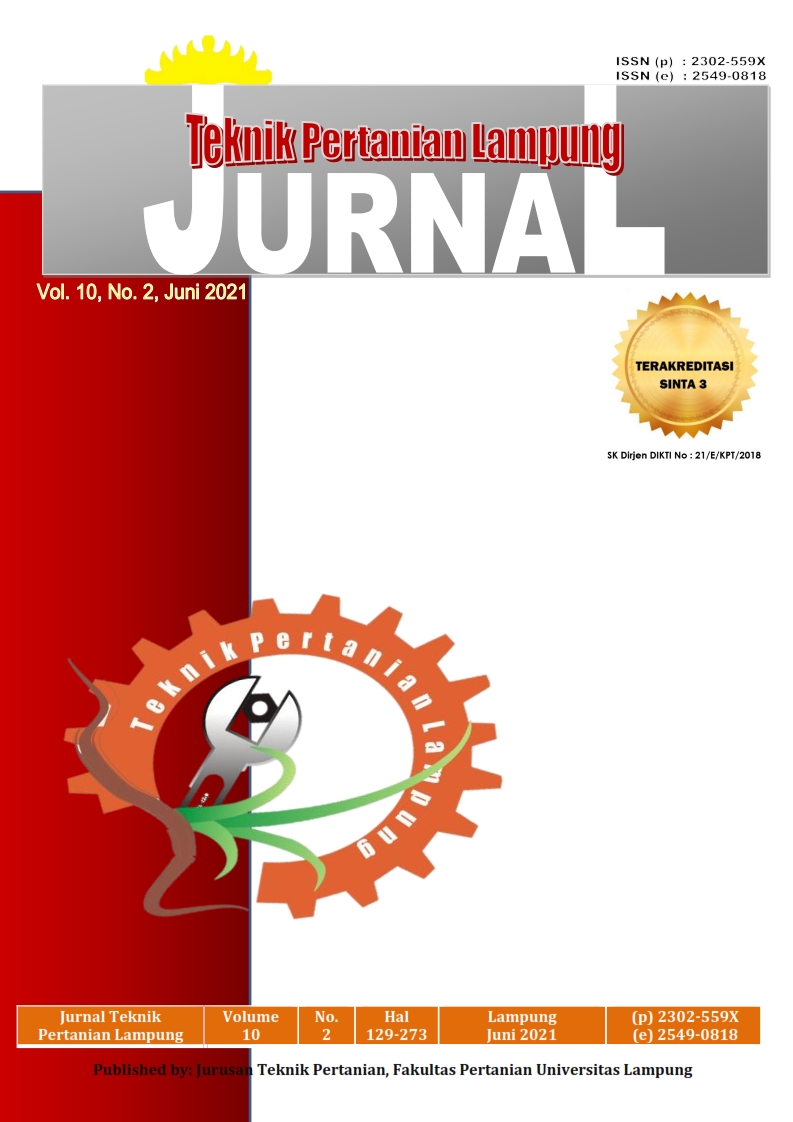KAJIAN PENERAPAN PRODUKSI BERSIH DI AGROINDUSTRI KOPI WULAN, KECAMATAN MAESAN, KABUPATEN BONDOWOSO
DOI:
https://doi.org/10.23960/jtep-l.v10i2.263-273Abstract
Wulan Coffee Agroindustry is one of agroindustries in region of Bondowoso that applies the semi-wet method and it has potential to be certified by Geographical Indications (IG). The wastes of arabica coffee processing at Wulan Coffee Agroindustry is directly thrown to the surrounding environment without being repaired first, because of that, it is worried that can affect human health and the environment. Therefore, further treatment is necessary to reduce the impact of waste pollutions and improve the efficiency of processing by using cleaner production technology. This study aimed to examine the priority alternative of cleaner production at Wulan Coffee Agroindustry. The method used in this study is descriptive quantitative with mass balance analysis, energy balance analysis, feasibility analysis, and priority analysis of cleaner production application using the method of AHP (Analytical Hierarchy Process). The waste management alternative in the Wulan Coffee Agroindustry were coffee pulp waste processing i.e. cascara tea, briquettes, and animal feed, also the waste water of coffee processing as biogas. The cleaner production applied in the Wulan Coffee Agroindustry had alternatives likes coffee green bean, coffee powder, and cascara tea. It was the priority scale to be applied because technically factor and financial factor consist of NPV, IRR, B/C ratio, and PBP were Rp 1.211.88.689; 49%; 6.27, and 0.76 or 9 month. Therefore, the result of AHP analysis using expert choice application showed that cascara tea was the priority alternative of cleaner production application with value of 15,4.
Keyword: arabica coffee, assessment, Bondowoso, feasibility analysis, waste utilization
References
Ariyanti, M., Purwanto, P. dan Suherman, S. 2013. Analisis Penerapan Produksi Bersih Menuju Industri Nata De Coco Ramah Lingkungan. Jurnal Riset Teknologi Pencegahan Industri, 5(2): 45-50. doi: 10.21771/jrtppi.2014.v5.no2.p45%20-%2050
Standar Nasional Indonesia (SNI). 2000. Teh Kering dalam Kemasan. Standar Nasional Indonesia (SNI). SNI-01-3836-2000. Jakarta Dewan Standarisasi Indonesia.
Budiawan, L., Hendrawan Y., dan Susilo, B. 2014. Pembuatan dan Karakterisasi Briket Biorang dengan Variasi Komposisi Kulit Kopi. Jurnal Bioproses Komoditas Tropis, 2(2): 152-160.
Direktorat Jenderal Perkebunan. 2017. Kopi. Jakarta.
Dianawati, M. dan Mulijanti S.L. 2015. Peluang Pengembangan Biogas di Sentra Sapi Perah. J. Litbang. Pert, 34(3): 125-134. doi: 10.21082/jp3.v34n3.2015.p125-134
Esquivel, P. dan Jimenez, V. M. 2012. Functional Properties of Coffee and Coffee by Product. Food Research International. 46(2): 488–495. doi: 10.1016/j.foodres.2011.05.028
Fitri, N. 2017. Pembuatan Briket dari Campuran Kulit Kopi (Coffea arabica) dan serbuk Gergaji dengan Menggunakan Getak Pinus (Pinus merkusii) Sebagai Perekat. [Skripsi]. Makasar: UIN Alauddin Makassar.
Indrasti, N.S. dan Fauzi, A.M.. 2009. Produksi Bersih. Bogor: IPB Press.
Kadariah. 2001. Evaluasi Proyek Analisis Ekonomi Edisi Kedua. Fakultas Ekonomi Universitas Indonesia. Jakarta.
Khotijah, Novita, E., dan Purbasari, D. 2019. Analisis Kelayakan Penerapan Produksi Bersih di Agroindustri Kopi Wulan Berpotensi Indikasi Geografis (Studi Kasus di Desa Tanah Wulan Kecamatan Maesan Kabupaten Bondowoso). Proceeding Series – Agropross: National Conference Proceesing of Agriculture, 38 – 45. Jember: Politeknik Negeri Jember. doi: 10.25047/agropross.2019.129
Londra, I.M., dan Sutami, P. 2013. Pengaruh Pemberian Kulit Kopi Fermentasi dan Leguminosa untuk Pertumbuhan Kambing Peranakan Etawah. Jurnal Informatika Pertanian, 22 (1): 45-55.
Marimin. 2004. Teknik dan Aplikasi Pengambilan Keputusan Kriteria Majemuk. Jakarta: PT.Grasindo.
Novita, E. 2012. Desain Proses Pengolahan Pada Agroindustri Kopi Robusta Menggunakan Modifikasi Teknologi Olah Basah Berbasis Produksi Bersih. [Disertasi]. Bogor: Institut Pertanian Bogor.
Novita, E., Wahyungsih, S., dan Pradana, H.A. 2018. Variasi Komposisi Input Proses Anaerobik untuk Produksi Biogas pada Penanganan Limbah Cair Kopi. Jurnal Agroteknologi, 12(1): 43-57. doi: 10.19184/j-agt.v12i1.7887
Novita, E., Pradana, H.A., Wahyuningsih, S., Marhaenanto, B., Sujarwo, M.H. dan Hafids, M.S.A. 2019. Variasi Digester Anaerobik Terhadap Produksi Biogas pada Penanganan Limbah Cair Pengolahan Kopi. Jurnal Teknik Pertanian Lampung, 8(3): 164-174. doi: 10.23960/jtep-l.v8.i3.164-174.
Novita, E., Suciati, L.P., Riawati, N., Andriyani, I., dan Pradana, H.A. 2020. Pendampingan Pengembangan Produk dan Metode Pemasaran pada Agroindustri Kopi Wulan Kabupaten Bondowoso. Jurnal Masyarakat Mandiri, 4(5): 859-869. doi: 10.31764/jmm.v4i5.3027.
Pandey. A., Soccol, C.R., Niagam, P., Brand D., Mohan, R., dan Roussos, S. 2000. Biotechnological Potential of Coffee Husk
for Bioprocesses. Journal Biochemical Engineering, 6(2): 153–162. Doi: 10.1016/s1369-703x(00)00084-x
Peraturan Menteri Lingkungan Hidup. 2014. Peraturan Menteri Lingkungan Hidup Republik Indonesia Nomor 5 Tahun 2014 tentang Baku Mutu Air Limbah. Jakarta.
Rojas, J. B. U., Amato, dan E. A. Huisman. 2003. Biological Treatments Affect The Chemical Composition of Coffee Pulp. Bioresource Technology, 5(89): 267–274. doi: 10.1016/S0960-8524(03)00070-1
Suryani, F., Homsah, F.O. dan Basuki M. 2018. Analisis pH dan Pengadukan Terhadap Produksi Biogas dari Limbah Cair Kelapa Sawit. Jurnal Riset Sains dan Teknologi, 2(1): 1-7. doi: 10.30595/jrst.v2i1.1855
Syarief, R., Novita, E., Noor, E. dan Mulato, S. 2012. Smallholder Coffee Processing Design Using Wet Technology Based on Clean Production. Journal of Applied Sciences in Environmental Sanitation, 7(2): 93-102.
Wardhana, I. D., Wibowo, Y., dan Suwasono, S. 2016. Strategi pengembangan agroindustri kopi yang berkelanjutan. Prosiding Seminar Nasional APTA , Jember 26 – 27 Oktober 2016.
Downloads
Published
Issue
Section
License
- Authors who publish with this journal agree to the following terms:
- Authors retain copyright and grant the journal right of first publication with the work simultaneously licensed under a Creative Commons Attribution-ShareAlike 4.0 International Lice that allows others to share the work with an acknowledgement of the work's authorship and initial publication in this journal.
- Authors are able to enter into separate, additional contractual arrangements for the non-exclusive distribution of the journal's published version of the work (e.g., post it to an institutional repository or publish it in a book), with an acknowledgement of its initial publication in this journal.
- Authors are permitted and encouraged to post their work online (e.g., in institutional repositories or on their website) prior to and during the submission process, as it can lead to productive exchanges, as well as earlier and greater citation of published work (See The Effect of Open Access).
Jurnal Teknik Pertanian Lampung

JTEPL is licensed under a Creative Commons Attribution-ShareAlike 4.0 International License.

